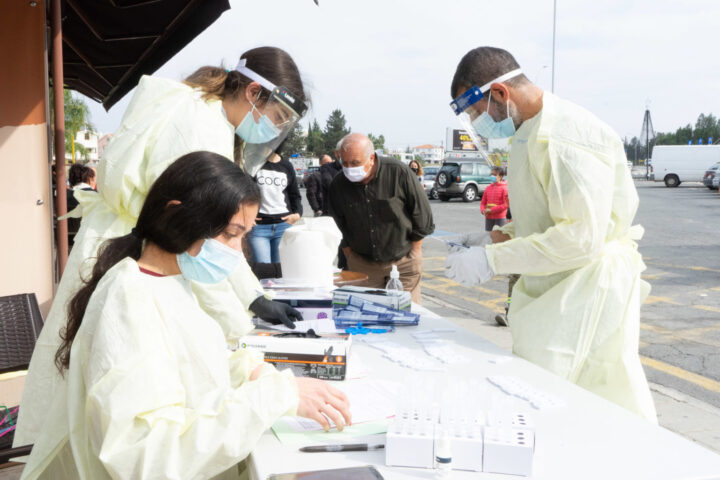Cyprus’ epidemiological picture has deteriorated with the COVID-19 transmission rate rising dangerously between 1.5-2, as authorities strive to tackle a huge spike in cases that peaked at 202.
According to the latest Health Ministry report released on Friday, the reproduction rate R(t) stood between 1.4 and 2.6 according to four models produced by its epidemiological surveillance team.
R(t) indicates the average number of people who contract a contagious disease from one infected person in real-time.
It specifically applies to a population who were previously free of infection and haven’t been vaccinated.
At the peak of the COVID-19 pandemic, a person infected with coronavirus could transmit it to four or five others on average, making it highly contagious.
In Cyprus, at the height of the first wave of infections in March, the R(t) was 3.
For Cyprus to exit lockdown measure the reproduction number had to be below one and stay there, which it succeeded doing in late May with the rate dropping to 0.65 in June.
Health officials reported 188 new SARS-CoV-2 cases on Thursday, approaching the record 202 announced last Saturday.
With the total number of coronavirus cases for October 1,399, stricter measures were introduced on Friday such as the mandatory wearing of masks outdoors and a night-time curfew for Limassol and Paphos.
However, the report has data up to 20 October before Wednesday’s 127 and Thursday’s 188 cases.
Α total of 2,704 COVID-19 cases and 32 deaths have been reported in the Republic of Cyprus, with the case fatality rate standing at 1.2% until October 20.
The reproduction number in Cyprus is between 1.5 and 2.
Up until Tuesday, some 2,704 laboratory-confirmed cases of COVID-19 were reported, with the 14-day cumulative number of new diagnoses, which reflects the number of active COVID cases in the population, standing at 95.9 per 100,000 population.
Up until 20 October, 32 deaths were reported in Cyprus with a Case Fatality Rate (CFR) of 1.2%. The mortality rate for COVID-19 is 3.7 per 100,000 population.
Twenty-three of the deceased (71.9%) were men and nine (28.1%) were women. The median age of all deaths was 76 years.
However, under the methodology adopted by the Health Ministry, COVID-19 was the underlying cause of death for only 25 fatalities, (COVID-19 CFR:0.9%).
In total, 9.9% (268) of cases received hospital care, and 24 (9%) were still hospitalized at the time of the report.
The median age of hospitalized patients was 60 years and 61.2% are males. There were two patients in intensive care units, both intubated as of October 20.
The majority of infections recorded were locally acquired amounting to 1,882 or 76.9% of 2,448 for which scientists know the source of their infection.
In the last 14 days, between 7-20 October, of 805 confirmed cases, 10.8% (87) were imported and 82.1% (661) were locally-acquired while the source of infection for some 7.1% (57) is still unknown.
Coronavirus seems to be infecting slightly more men as 52.3% of cases were male and 47.7% female.
By age group, 220 cases involved infants, children and adolescents aged 0-17 (8.1%), 2,079 adults aged 18-59 (76.9%), 400 persons aged 60 and older (14.8%), and for five cases information was missing.
The median age of all cases is 35years.
The median age among adult cases (≥ 18 years) is 37 years.
Limassol was the district hit the most by the virus with 784 cases (29%), followed by Nicosia with 654 (24.2%), Larnaca had 629 (23.3%), Paphos 309 (11.4%), and Famagusta with 147 (5.4%).
Some 181 cases (6.7%) were reported either in the British bases or had a residence abroad, or information was not available.
Clinical information is available for 97.4% (2,633) of 2,704 laboratory-confirmed COVID-19-cases, of which 37.1% (977) reported no symptoms at diagnosis and 62.9% (1,656) reported at least one symptom.
The most commonly reported symptoms among symptomatic cases were cough (640/1,633; 39.2%), fever (734/1,635; 44.9%), myalgia (560/1,628; 34.4%), sore throat (437/1,630; 26.8%), anosmia (299/1,539; 19.4%), and shortness of breath (173/1,609; 10.8%).
Other reported symptoms were diarrhoea, runny nose, and headaches.
A total of 444,911 tests have been performed (50,794.7 per 100,000 population, which is higher than the 41,705.9 performed by the UK and the 22,836.8 performed by Italy.










